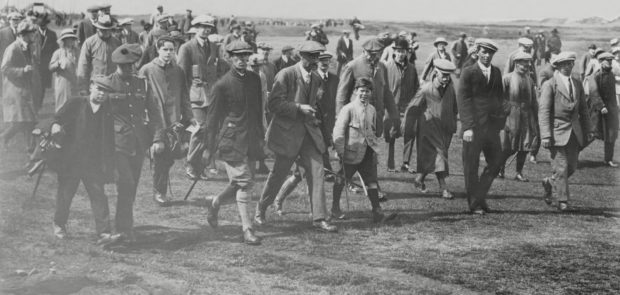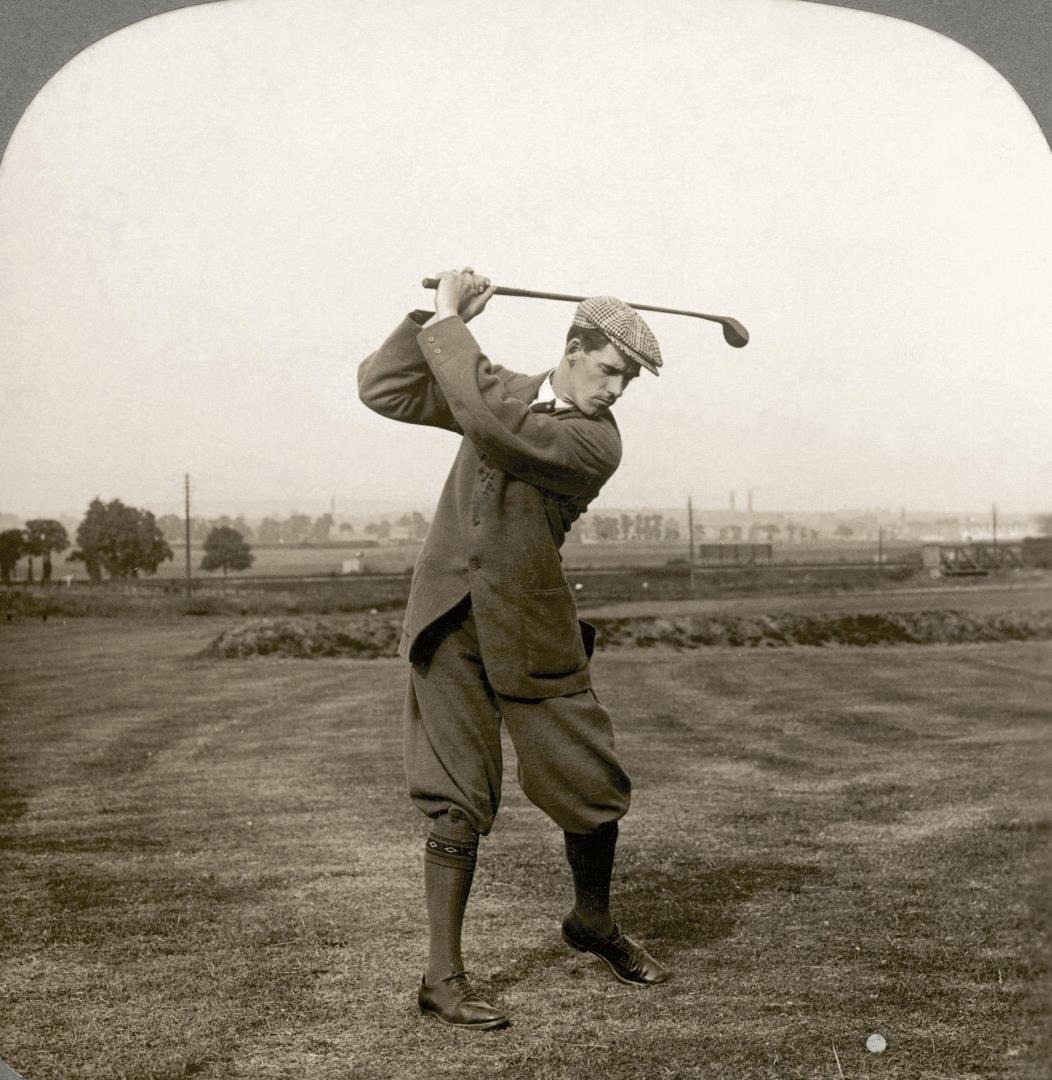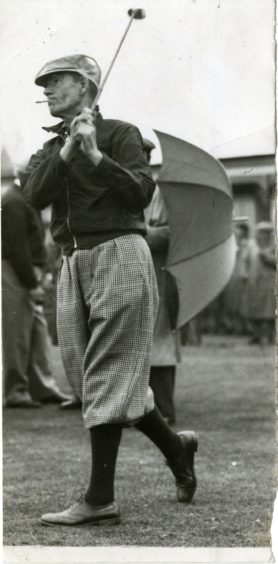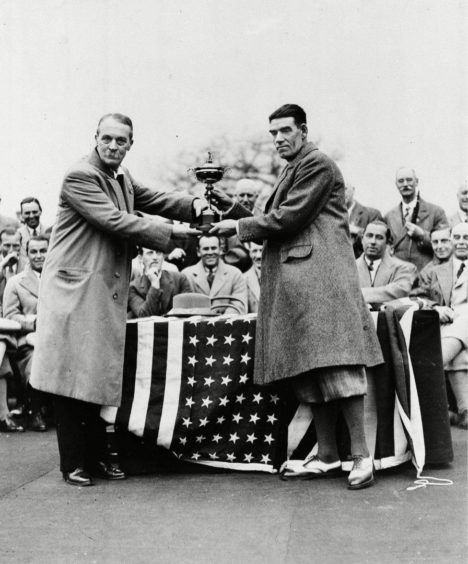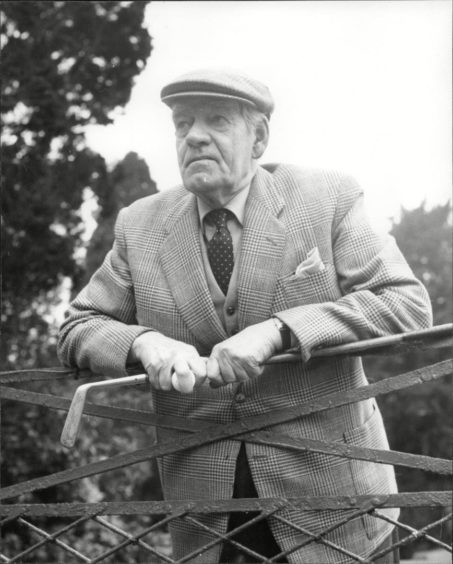He was the policeman’s son who was the original ‘Wild Thing’ on the golf course.
The greatest golfer the north-east has ever produced, George Duncan won The Open 100 years ago in one of sport’s greatest comebacks.
Duncan was described by Vanity Fair magazine as the “fastest living golfer” following his victory over the Deal course at Royal Cinque Ports in Kent in 1920.
He was also a pioneering influence on the development of The Open and of the sport in Britain and competed with some of golf’s greatest players before captaining a victorious Great Britain side to the Ryder Cup in 1929.
Well known for his fast pace of play, he would simply walk to his ball, immediately drop his limbs into his stance and hit the ball.
The ‘Lightning Artist’ did not believe in taking a practice swing and regarded it as totally unnecessary and barely legal and close to practising on the course.
Born in 1883 in Methlick, Aberdeenshire, Duncan started caddying at the age of eight at Aberdeen Links where he learned his golf.
In his autobiography he recounted how the player he was caddying for was so bad and so slow that he couldn’t take it so he walked off the course.
Duncan was a keen pupil of Jim Donaldson, who went on to become a professional in the United States.
He studied Donaldson’s style, as well as that of Archie Simpson, another pro at that time, and was also much influenced by the famous Harry Vardon, who won The Open a record six times, and also won the 1900 US Open.
Duncan was first apprenticed as a carpenter and rejected the chance to become a footballer at Aberdeen to follow a career in golf.
He came to Stonehaven Golf Club in 1901 as a novice professional and worked in the club for a year or so before heading south to pursue his career at various clubs in Wales, Cheshire and then London.
In 1920, in the first Open to be held after the First World War, Duncan was still 13 shots behind the leader Abe Mitchell after starting with two rounds of 80.
Duncan went on to shoot 71 in the third round and Mitchell started nervously on the final day, leaving a tap-in on the first six inches short and took an eight at the fifth on the way to an 84.
Duncan closed with a 72 to win by two from Sandy Herd and three from Ted Ray.
He put his recovery down to purchasing a new driver from the exhibition tent at Royal Cinque Ports.
He remains the last player to win a golf major with a score of 80 for a round.
His reward was a gold medal and £75.
Duncan and Mitchell were christened “the New Mandarins of Golf” by Grantland Rice in Vanity Fair magazine before the US Open in Washington in 1921.
Rice, who established himself over many years as one of America’s leading sports authorities, described Duncan as “the fastest living golfer” who wouldn’t let his nerves obstruct his game.
He wrote: “Duncan, who won the British Open last June at Deal, is a bundle of nerves who might almost as well be moving on a motor cycle.
“Being nervous, Duncan steps up and hits the ball before he has time to think about it.
“Duncan knows he can’t afford to waste an extra second and give his highly charged nerves a chance.
“So you will frequently see him play his second shot almost before he stops, and when it comes to the greens, you will suddenly see the ball leave his putter before you knew he was close enough to hit it.
“The world was built in less time than many golfers waste in a month.
“Duncan has shown that one can get his par without taking an entire day to find it.”
George Duncan erased a 13-stroke deficit after 36 holes to win his only major title at the 1920 Open Championship.
He won by two strokes ahead of runner-up, Sandy Herd.Duncan's scores were 80-80-71-72 = 303 and he won £75. pic.twitter.com/XixRv2VJzc
— TheGolfDivoTee™ (@TheGolfDivoTee) May 23, 2020
Duncan finished second in The Open in 1922 to the great US player Walter Hagen, losing by one shot.
His third round score of 69 was only the third round under 70 in Open history to that point and was included as one of the 25 greatest rounds of golf ever played in the Guinness Book of Golf Records Facts and Champions.
The scene of his demise was a dip in the fairway in front of the 18th green from which he fluffed a chip shot to a position five yards short of the pin.
He eventually missed the crucial putt for a tie with Hagen, which led to the short position in front of the 18th being ironically named “Duncan’s Hollow”.
In 1985 Sandy Lyle did exactly the same at The Open, finding Duncan’s Hollow and taking five, but he still claimed victory.
Allowing for the war years, in the nine Opens he played between 1910 and 1924, Duncan was never out of the top ten.
Duncan also won the Irish, French and Belgian Opens, among others, during a distinguished career.
He first played for Scotland in 1906 against England and it was the start of a remarkable record of international appearances.
He last represented Scotland in 1936 and in those 30 years he was one of the great names in golf.
He played for Great Britain against America in 1921 and 1926 before he was influential in the birth of the Ryder Cup.
Along with fellow pros Hagen, Mitchell and Emmett French, Duncan suggested to Samuel Ryder that the informal golf matches between Great Britain and the USA should be developed into something more official.
Ryder, an English entrepreneur and golf promoter, agreed and put up some cash for team travel expenses and commissioned a golden chalice as a prize.
Duncan played in the first official match of the Ryder Cup in 1927 before captaining Great Britain to victory in April 1929.
The second Ryder Cup match took place in blustery April conditions, with 10,000 fans flocking to Leeds to see the famous Americans in action.
The US team were forced to bring their old hickory-shafted clubs as their new-fangled steel versions were still illegal.
The US began well, winning the foursomes, but the tide turned in the singles, not least in the match between the two skippers.
Duncan overheard his opposite number Walter Hagen telling Gene Sarazen he would be guaranteed a point when he faced Duncan in the singles.
Outraged, Duncan went out and won the 36-hole contest and Britain won the Ryder Cup 7-5.
He also played for Great Britain in the Ryder Cup in 1931 at the age of 47 and the US won 9-3 with Hagen now the US captain.
His much sought-after professional teaching and swing analysis skills led to him being referred to as “the pros pro”.
He also became a golf course designer and had a club-making business which produced autograph models with iron heads made by Gibson in Kinghorn and a brassie made by Spalding.
Gibson was one of the first to manufacture autographed branded golf clubs with the George Duncan Autograph model being amongst some of the other popular models such as James Braid, Hugh Logan and Jack White.
Gibson made the George Duncan Autograph models from 1910 until around 1924.
Duncan called his autobiography Golf At The Gallop and published two other golf books, Golf for Women (in 1912) and Present Day Golf with Bernard Darwin in 1921.
Duncan retired from professional golf at the age of 64 in 1947 after 50 years in the game.
He was still working with the Mere club in Cheshire up until 1962.
His 1929 Ryder Cup win was commemorated by the Moortown club on the occasion of his 80th birthday in September 1963 when they held a dinner in his honour.
He died the following January at his home in Leeds.
